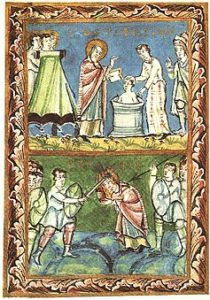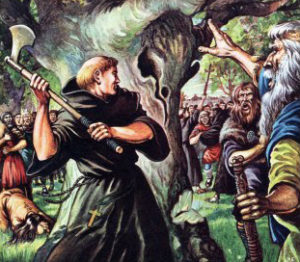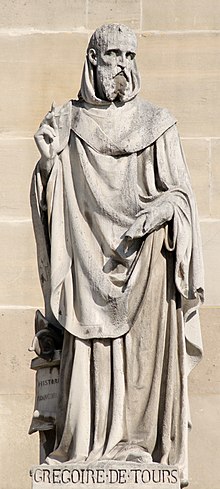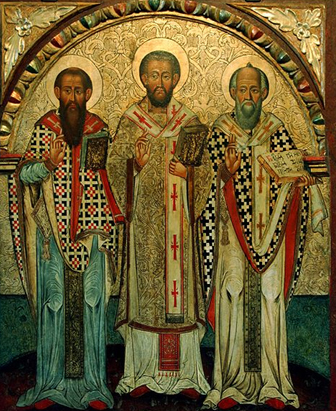St Boniface, ‘Apostle of the Germans’ and of Rome
 The Greatest Englishman. —Title of an anthology by Timothy Reuter
The Greatest Englishman. —Title of an anthology by Timothy Reuter
‘He was an utterly devoted person, one might almost say tender, not a tempestuous personality or a force of nature. A man of utterly pure and lofty idealism’. —Wilhelm Neuss
‘Moreover, any historian—including an atheist—should recognise that Boniface opened the door wide for us, that through him the frontier of Europe was opened to the east. The same is true of Charles’s wars against the Saxons’. —K. König and K. Witte
‘Boniface, who has influenced the history of Europe more profoundly than any other Englishman after him, was not just a missionary but a statesman and a genius of administration, and above all a servant of the Roman order’. —Christopher Dawson
‘The glory of the Middle Ages rests in a good part on his work’. —Joseph Lortz, Catholic theologian
Around 680, probably at the age of seven, the Anglo-Saxon boy Wynfreth (Winfrid), later called Bonifatius in Rome, was given by his father to the monastery as puer oblatas.
Editor’s Note: Anyone familiar with what we have quoted on this site from historian Lloyd deMause will know that paedophilia is not a recent phenomenon in the Catholic Church. From its earliest days parents who didn’t love their young donated them to monasteries—the institution of Oblation—where they could be sexually used by the elders. Deschner continues:
‘But the boy, who had been entrusted to the monastery without consulting his will, grew up to become a man of his own free will’, writes the German scholar Schramm today. In a monastery! A man of his own free will? As if Boniface had not been a servile slave of Rome for the rest of his life! ‘Day and night he cultivated scientific studies to procure eternal happiness’, according to the priest Willibaid in his bombastic Vita, which he wrote about his monastic hero in Mainz at the end of the 8th century.
Boniface began a propagandistic pilgrimage, but with a ‘missionary authorisation’ from Rome. Pope Gregory II (715-731) commissioned him on 15 May 719 ‘to exercise the service of the kingdom of God among all peoples imprisoned in the error of unbelief’. He was to examine—again in the poetic language of the biographer Willibald—‘whether the uncultivated fields of their hearts were to be ploughed by the plough of the gospel’.
Deliverance from ‘all uncleanness’ among the people of Hesse, Thuringia, Saxony and some bloodshed
The inhabitants of Hesse were still largely pagan, while the Thuringians—among whom the Frankish conquerors built the first churches in their feudal castles—had been partially converted to paganism by Saxon raids and pagan reactions. In any case, despite his honey-sweet doctrine, Boniface quickly failed here, partly because of the Christian bishops and priests and partly because of the lack of military support.
Still in 719 he left Thuringia and went, ‘filled with great joy’ at the death of the Frisian Duke Radbod (according to Vita Bonifatii), to Frisia until 721, where he was placed under the command of the elderly missionary Willibrord, an ‘Oblate’ like himself, i.e. already spiritually violated as a child.
With the backing of the high Frankish nobility and the force of Frankish arms, Willibrord had, since 690, spread his knowledge among the West Frisians under Pippin II and, briefly and unsuccessfully, among the Danes and Saxons. He fled from Radbod with little apparent martyr’s vocation and only returned after his death. Only the victorious campaigns of Charles Martell in 718 and 720 (repeated in 722 and 724) against the Saxons made possible the beginning of their Christianisation, their liberation from ‘demons’, ‘error’ and ‘diabolical fraud’ (Gregory II). With the invocation of the Holy Trinity, Willibrord destroyed the ‘idols’, desecrated and reduced to ruins the sanctuaries of the Frisians, killed their sacred animals and worked astonishing miracles. To put it briefly: it was in connection with the military men Pippin and Charles Martell that he weeded out ‘the tares of unbelief’ and strove to ‘renew by baptism those who had just been subdued by force of arms’ and ‘to spread without delay all the light of the gospel’ (Alcuin).
In 721 Boniface separated from Willibrord for reasons we ignore. He had refused to be consecrated bishop by Willibrord and returned to the territory of Hesse-Thuringia, where he founded a small monastery on the Amoneburg… After the first successes Gregory II called Bonifacius back and on 30 November 722 consecrated him a missionary bishop (without a fixed see). He thus became entirely bound to Rome by oath…
Boniface benefited from the campaigns of Charles Martel and his donations to the church of Utrecht and the monastery of Echternach, which soon became the basis of gigantic Catholic propaganda that extended as far as the Meuse, the Scheldt and the mouths of the Rhine.
In 722 Gregory II had also given the ‘apostle of the Germans’ a missionary commission for the Saxons. It is true that in 718 they had been driven out of the lower Rhine and defeated by Charles, but they remained almost entirely faithful to their ancient beliefs. They were one of those Germanic tribes east of the Rhine. The planned ‘conversion’ of the Saxons with mass baptisms only came about after Charles’ long and carefully prepared campaign of 738, which was carried out in close cooperation with the clergy. Gregory III (731-741), who once called the Frankish warlord who waged war almost year after year ‘St Peter’s beloved son’, declared the following in a letter to Boniface on 29 October 739:
You have given us knowledge of the peoples of Germania, whom God has delivered from the power of the pagans, by having gathered into the bosom of the holy mother Church hundreds of thousands of souls by your efforts and those of the Frankish prince Charles (tuo conamine et Caroli principis Francoruni).
The number is certainly exaggerated. But the Saxons were ‘delivered from the power of the heathen’ only by the military expedition of Charles Martell (738) ‘with dreadful bloodshed’ (Fredegarii continuationes). And in connection with this came the mass baptisms of the Saxons. Their conversion to Christianity took place ‘in close contact with the military-political organisation’ (Steinbach). This is probably even a ‘large-scale attempt at a Saxon mission before the period of Charlemagne’ (Schieffer).
It is true that Charles Martell was not very religious, but for political reasons he was ‘extremely interested’ (Buchner) in the spread of Christianity in the east. And there is no doubt that Boniface ‘owed everything to the victorious arms and personal protection of Charles Martell’ (Zwölfer).
Already in the years 718, 720, 722 and 724 Charles had fought against the Saxons, as mentioned above. He repeatedly crushed uprisings of the Frisians and Saxons, and it was only through these bloody acts of violence that the ‘conversion’ or, as Boniface puts it, the liberation of ‘all the heathen’s filth’ depended. Gregory III attributed the missionary success as much to Charles Martell as to Boniface. And Boniface personally confesses to the English bishop Daniel of Winchester: ‘Without the protection of the prince of the Franks (sine patrocinio principis Francorum) I could neither have guided the people of the Church nor defended the priests and ecclesiastics, the monks and servants of God, nor without his command and his fear could I have eliminated the pagan customs and the horrors of idolatry in Germania’.




